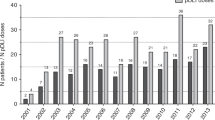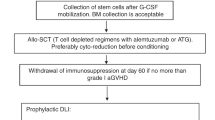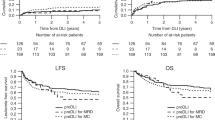Abstract
Donor lymphocyte infusions (DLI) often are used after allo-SCT to augment the graft-versus-tumor effect. Timing of infusion varies according to indication, for example to treat tumor recurrence, as a planned strategy to prevent disease relapse in the setting of T-cell-depleted grafts or non-myeloablative conditioning regimens, or as a method to convert mixed to full donor chimerism. The optimal strategy of timing, use of cytotoxic conditioning, cell dose and cell product composition, and so on, for DLI administration remains unclear. Despite varied techniques, DLI may lead to 3-year disease-free survivals (DFS) in excess of 60% for all CML patients and approach 90% in patients with only molecular or cytogenetic relapse. Other hematologic malignancies appear much less responsive, as less than 50% of patients respond and provide, at best, 3-year DFS rates of 20–50%. Multiple myeloma patients have overall response rates of 40–45% after DLI, suggesting benefit in relapsed disease, but limited experiences for diseases such as Hodgkin's lymphoma, myelodysplasia and ALL preclude recommendations for use of DLI at this time. Regardless of the indication, treatment-related mortality after DLI is 5–20% and more than one-third of patients will develop acute and/or chronic GVHD after DLI. The risks of these complications appear related, in part, to donor source, cell dose and therapy prior to DLI. Although there are no definitive answers, the information gleaned from published literature suggests that DLI should be administered early after relapse or as a prophylactic strategy in patients receiving T-cell-depleted grafts, and patients with bulky or aggressive disease may benefit from disease reduction prior to DLI.
This is a preview of subscription content, access via your institution
Access options
Subscribe to this journal
Receive 12 print issues and online access
$259.00 per year
only $21.58 per issue
Buy this article
- Purchase on Springer Link
- Instant access to full article PDF
Prices may be subject to local taxes which are calculated during checkout
Similar content being viewed by others
References
CIBMTR Summary Slides. http://www.cibmtr.org/SERVICES/Observational_Research/Summary_Slides/index.html.
Kolb HJ, Mittermuller J, Clemm C, Holler E, Ledderose G, Brehm G et al. Donor leukocyte transfusions for treatment of recurrent chronic myelogenous leukemia in marrow transplant patients. Blood 1990; 76: 2462–2465.
Chiorean EG, DeFor TE, Weisdorf DJ, Blazar BR, McGlave PB, Burns LJ et al. Donor chimerism does not predict response to donor lymphocyte infusion for relapsed chronic myelogenous leukemia after allogeneic hematopoietic cell transplantation. Biol Blood Marrow Transplant 2004; 10: 171–177.
Huff CA, Fuchs EJ, Smith BD, Blackford A, Garrett-Mayer E, Brodsky RA et al. Graft-versus-host reactions and the effectiveness of donor lymphocyte infusions. Biol Blood Marrow Transplant 2006; 12: 414–421.
Raiola A, Van Lint M, Valbonesi M, Lamparelli T, Gualandi F, Occhini D et al. Factors predicting response and graft-versus-host disease after donor lymphocyte infusions: a study on 593 infusions. Bone Marrow Transplant 2003; 31: 687.
Alyea EP, Soiffer RJ, Canning C, Neuberg D, Schlossman R, Pickett C et al. Toxicity and efficacy of defined doses of CD4+ donor lymphocytes for treatment of relapse after allogeneic bone marrow transplant. Blood 1998; 91: 3671–3680.
Collins R, Shpilberg O, Drobyski W, Porter D, Giralt S, Champlin R et al. Donor leukocyte infusions in 140 patients with relapsed malignancy after allogeneic bone marrow transplantation. J Clin Oncol 1997; 15: 433–444.
Verdonck LF, Petersen EJ, Lokhorst HM, Nieuwenhuis HK, Dekker AW, Tilanus MGJ et al. Donor leukocyte infusions for recurrent hematologic malignancies after allogeneic bone marrow transplantation: impact of infused and residual donor T cells. Bone Marrow Transplant 1998; 22: 1057.
Marks DI, Lush R, Cavenagh J, Milligan DW, Schey S, Parker A et al. The toxicity and efficacy of donor lymphocyte infusions given after reduced-intensity conditioning allogeneic stem cell transplantation. Blood 2002; 100: 3108–3114.
Michallet AS, Nicolini F, Furst S, Le QH, Dubois V, Hayette S et al. Outcome and long-term follow-up of alloreactive donor lymphocyte infusions given for relapse after myeloablative allogeneic hematopoietic stem cell transplantations (HSCT). Bone Marrow Transplant 2005; 35: 601–608.
Shaw BE, Byrne JL, Das-Gupta E, Carter GI, Russell NH . The impact of chimerism patterns and predonor leukocyte infusion lymphopenia on survival following T cell-depleted reduced intensity conditioned transplants. Biol Blood Marrow Transplant 2007; 13: 550–559.
Or R, Hadar E, Bitan M, Resnick IB, Aker M, Ackerstein A et al. Safety and efficacy of donor lymphocyte infusions following mismatched stem cell transplantation. Biol Blood Marrow Transplant 2006; 12: 1295–1301.
Dominietto A, Pozzi S, Miglino M, Albarracin F, Piaggio G, Bertolotti F et al. Donor lymphocyte infusions for the treatment of minimal residual disease in acute leukemia. Blood 2007; 109: 5063–5064.
Keil F, Haas OA, Fritsch G, Kalhs P, Lechner K, Mannhalter C et al. Donor leukocyte infusion for leukemic relapse after allogeneic marrow transplantation: lack of residual donor hematopoiesis predicts aplasia. Blood 1997; 89: 3113–3117.
Platzbecker U, Thiede C, Freiberg-Richter J, Helwig A, Mohr B, Prange G et al. Treatment of relapsing leukemia after allogeneic blood stem cell transplantation by using dose-reduced conditioning followed by donor blood stem cells and GM-CSF. Ann Hematol 2001; 80: 144–149.
Schattenberg A . In relapsed patients after lymphocyte depleted bone marrow transplantation the percentage of donor T lymphocytes correlates well with the outcome of donor leukocyte infusion. Leuk Lymphoma 1999; 32: 317.
Goerner M, Weber-Nordt R, Hoepfner S, Benner A, Luft T, Ho AD . Addition of a low fixed number of CD3+ cells to CD34-enriched allografts: effects on engraftment, graft-versus-host disease, and survival after related and unrelated peripheral stem cell transplantation. J Hematother Stem Cell Res 2003; 12: 309–320.
Grigg A, Kannan K, Schwarer AP, Spencer A, Szer J . Chemotherapy and granulocyte colony stimulating factor-mobilized blood cell infusion followed by interferon-alpha for relapsed malignancy after allogeneic bone marrow transplantation. Intern Med J 2001; 31: 15–22.
Peggs KS, Thomson K, Hart DP, Geary J, Morris EC, Yong K et al. Dose-escalated donor lymphocyte infusions following reduced intensity transplantation: toxicity, chimerism, and disease responses. Blood 2004; 103: 1548–1556.
Barrett AJ, Mavroudis D, Tisdale J, Molldrem J, Clave E, Dunbar C et al. T cell-depleted bone marrow transplantation and delayed T cell add-back to control acute GVHD and conserve a graft-versus-leukemia effect. Bone Marrow Transplant 1998; 21: 543–551.
Schaap N, Schattenberg A, Bar B, Preijers F, van de Wiel van Kemenade E, de Witte T . Induction of graft-versus-leukemia to prevent relapse after partially lymphocyte-depleted allogeneic bone marrow transplantation by pre-emptive donor leukocyte infusions. Leukemia 2001; 15: 1339–1346.
Montero A, Savani BN, Shenoy A, Read EJ, Carter CS, Leitman SF et al. T cell depleted peripheral blood stem cell allotransplantation with T cell add back for patients with hematological malignancies: effect of chronic GVHD on outcome. Biol Blood Marrow Transplant 2006; 12: 1318–1325.
Lee C, de Magalhaes-Silverman M, Hohl RJ, Hayashi M, Buatti J, Wen BC et al. Prophylactic T cell infusion after T cell-depleted bone marrow transplantation in patients with refractory lymphoma. Bone Marrow Transplant 2002; 29: 615.
Ferra C, Rodriguez-Luaces M, Gallardo D, Encuentra M, Martin-Henao GA, Peris J et al. Individually adjusted prophylactic donor lymphocyte infusions after CD34-selected allogeneic peripheral blood stem cell transplantation. Bone Marrow Transplant 2001; 28: 963–968.
Nakamura R, Bahceci E, Read EJ, Leitman SF, Carter CS, Childs R et al. Transplant dose of CD34+ and CD3+ cells predicts outcome in patients with haematological malignancies undergoing T cell-depleted peripheral blood stem cell transplants with delayed donor lymphocyte add-back. Br J Haematol 2001; 115: 95–104.
Sohn SK, Jung JT, Kim DH, Lee NY, Seo KW, Chae YS et al. Prophylactic growth factor-primed donor lymphocyte infusion using cells reserved at the time of transplantation after allogeneic peripheral blood stem cell transplantation in patients with high-risk hematologic malignancies. Cancer 2002; 94: 18–24.
Barge RMY, Osanto S, Marijt WAFE, Starrenburg CWJI, Fibbe WE, Nortier JWRH et al. Minimal GVHD following in-vitro T-cell-depleted allogeneic stem cell transplantation with reduced-intensity conditioning allowing subsequent infusions of donor lymphocytes in patients with hematological malignancies and solid tumors. Exp Hematol 2003; 31: 865–872.
de Lima M, Bonamino M, Vasconcelos Z, Colares M, Diamond H, Zalcberg I et al. Prophylactic donor lymphocyte infusions after moderately ablative chemotherapy and stem cell transplantation for hematological malignancies: high remission rate among poor prognosis patients at the expense of graft-versus-host disease. Bone Marrow Transplant 2001; 27: 73.
Simula MP, Marktel S, Fozza C, Kaeda J, Szydlo RM, Nadal E et al. Response to donor lymphocyte infusions for chronic myeloid leukemia is dose-dependent: the importance of escalating the cell dose to maximize therapeutic efficacy. Leukemia 2007; 21: 943–948.
Mackinnon S, Papadopoulos E, Carabasi M, Reich L, Collins N, Boulad F et al. Adoptive immunotherapy evaluating escalating doses of donor leukocytes for relapse of chronic myeloid leukemia after bone marrow transplantation: separation of graft-versus-leukemia responses from graft-versus-host disease. Blood 1995; 86: 1261–1268.
Shimoni A, Gajewski J, Donato M, Martin T, O′Brien S, Talpaz M et al. Long-term follow-up of recipients of CD8-depleted donor lymphocyte infusions for the treatment of chronic myelogenous leukemia relapsing after allogeneic progenitor cell transplantation. Biol Blood Marrow Transplant 2001; 7: 568–575.
Bacigalupo A, Soracco M, Vassallo F, Abate M, Van Lint MT, Gualandi F et al. Donor lymphocyte infusions (DLI) in patients with chronic myeloid leukemia following allogeneic bone marrow transplantation. Bone Marrow Transplant 1997; 19: 927–932.
Dazzi F, Szydlo RM, Cross NCP, Craddock C, Kaeda J, Kanfer E et al. Durability of responses following donor lymphocyte infusions for patients who relapse after allogeneic stem cell transplantation for chronic myeloid leukemia. Blood 2000; 96: 2712–2716.
Drobyski WR, Hessner MJ, Klein JP, Kabler-Babbitt C, Vesole DH, Keever-Taylor CA . T-cell depletion plus salvage immunotherapy with donor leukocyte infusions as a strategy to treat chronic-phase chronic myelogenous leukemia patients undergoing HLA-identical sibling marrow transplantation. Blood 1999; 94: 434–441.
Posthuma EFM, Marijt EWAF, Barge RMY, van Soest RA, Baas IO, Starrenburg CWJI et al. α-Interferon with very-low-dose donor lymphocyte infusion for hematologic or cytogenetic relapse of chronic myeloid leukemia induces rapid and durable complete remissions and is associated with acceptable graft-versus-host disease. Biol Blood Marrow Transplant 2004; 10: 204–212.
Guglielmi C, Arcese W, Dazzi F, Brand R, Bunjes D, Verdonck LF et al. Donor lymphocyte infusion for relapsed chronic myelogenous leukemia: prognostic relevance of the initial cell dose. Blood 2002; 100: 397–405.
Fozza C, Szydlo RM, Abdel-Rehim MM, Nadal E, Goldman JM, Apperley JF et al. Factors for graft-versus-host disease after donor lymphocyte infusions with an escalating dose regimen: lack of association with cell dose. Br J Haematol 2007; 136: 833–836.
Vela-Ojeda J, Garcia-Ruiz Esparza MA, Reyes-Maldonado E, Jimenez-Zamudio L, Moreno-Lafont M, Garcia-Latorre E et al. Donor lymphocyte infusions for relapse of chronic myeloid leukemia after allogeneic stem cell transplantation: prognostic significance of the dose of CD3(+) and CD4(+) lymphocytes. Ann Hematol 2004; 83: 295–301.
Giralt S, Hester J, Huh Y, Hirsch-Ginsberg C, Rondon G, Seong D et al. CD8-depleted donor lymphocyte infusion as treatment for relapsed chronic myelogenous leukemia after allogeneic bone marrow transplantation. Blood 1995; 86: 4337–4343.
Schmid C, Labopin M, Nagler A, Bornhauser M, Finke J, Fassas A et al. Donor lymphocyte infusion in the treatment of first hematological relapse after allogeneic stem-cell transplantation in adults with acute myeloid leukemia: a retrospective risk factors analysis and comparison with other strategies by the EBMT Acute Leukemia Working Party. J Clin Oncol 2007; 25: 4938–4945.
Campregher PV, Gooley T, Scott BL, Moravec C, Sandmaier B, Martin PJ et al. Results of donor lymphocyte infusions for relapsed myelodysplastic syndrome after hematopoietic cell transplantation. Bone Marrow Transplant 2007; 40: 965–971.
Depil S, Deconinck E, Milpied N, Sutton L, Witz F, Jouet JP et al. Donor lymphocyte infusion to treat relapse after allogeneic bone marrow transplantation for myelodysplastic syndrome. Bone Marrow Transplant 2004; 33: 531–534.
Yoshimi A, Bader P, Matthes-Martin S, Stary J, Sedlacek P, Duffner U et al. Donor leukocyte infusion after hematopoietic stem cell transplantation in patients with juvenile myelomonocytic leukemia. Leukemia 2005; 19: 971–977.
Worth A, Rao K, Webb D, Chessells J, Passmore J, Veys P . Successful treatment of juvenile myelomonocytic leukemia relapsing after stem cell transplantation using donor lymphocyte infusion. Blood 2003; 101: 1713–1714.
Pulsipher MA, Adams RH, Asch J, Petersen FB . Successful treatment of JMML relapsed after unrelated allogeneic transplant with cytoreduction followed by DLI and interferon-alpha: evidence for a graft-versus-leukemia effect in non-monosomy-7 JMML. Bone Marrow Transplant 2004; 33: 113–115.
Cervantes F, Rovira M, Urbano-Ispizua A, Rozman M, Carreras E, Montserrat E . Complete remission of idiopathic myelofibrosis following donor lymphocyte infusion after failure of allogeneic transplantation: demonstration of a graft-versus-myelofibrosis effect. Bone Marrow Transplant 2000; 26: 697.
Atra A, Millar B, Shepherd V, Shankar A, Wilson K, Treleaven J et al. Donor lymphocyte infusion for childhood acute lymphoblastic leukaemia relapsing after bone marrow transplantation. Br J Haematol 1997; 97: 165–168.
Baron F, Frere P, Fillet G, Beguin Y . Treatment of leukemia relapse after allogeneic hematopoietic stem cell transplantation by donor lymphocyte infusion and STI-571. Haematologica 2001; 86: 993–994.
Ishikawa J, Maeda T, Kashiwagi H, Yoshida H, Takahashi I, Kawamoto S et al. Successful second allogeneic peripheral blood stem cell transplantation and donor lymphocyte infusion in patients with relapsed acute leukemia using the same donors as for the initial allogeneic bone marrow transplantation. Bone Marrow Transplant 2003; 31: 1057.
De Rosa G, Pezzullo L, Scarpato N, Selleri C, Lucania A, Rotoli B . Donor lymphocyte infusion for post-transplant relapse of Hodgkin's lymphoma. Haematologica 2000; 85: 780–781.
Anderlini P, Acholonu SA, Okoroji GJ, Andersson BS, Couriel DR, De Lima MJ et al. Donor leukocyte infusions in relapsed Hodgkin's lymphoma following allogeneic stem cell transplantation: CD3+ cell dose, GVHD and disease response. Bone Marrow Transplant 2004; 34: 511–514.
Russell NH, Byrne JL, Faulkner RD, Gilyead M, Das-Gupta EP, Haynes AP . Donor lymphocyte infusions can result in sustained remissions in patients with residual or relapsed lymphoid malignancy following allogeneic haemopoietic stem cell transplantation. Bone Marrow Transplant 2005; 36: 437–441.
Espanol I, Buchler T, Ferra C, Gallardo D, Reyes P, Sarra J et al. Richter's syndrome after allogeneic stem cell transplantation for chronic lymphocytic leukaemia successfully treated by withdrawal of immunosuppression, and donor lymphocyte infusion. Bone Marrow Transplant 2003; 31: 215.
Mandigers CM, Verdonck LF, Meijerink JP, Dekker AW, Schattenberg AV, Raemaekers JM . Graft-versus-lymphoma effect of donor lymphocyte infusion in indolent lymphomas relapsed after allogeneic stem cell transplantation. Bone Marrow Transplant 2003; 32: 1159–1163.
Bloor AJC, Thomson K, Chowdhry N, Verfuerth S, Ings SJ, Chakraverty R et al. High response rate to donor lymphocyte infusion after allogeneic stem cell transplantation for indolent non-Hodgkin lymphoma. Biol Blood Marrow Transplant 2008; 14: 50–58.
Lokhorst HM, Wu K, Verdonck LF, Laterveer LL, van de Donk NW, van Oers MH et al. The occurrence of graft-versus-host disease is the major predictive factor for response to donor lymphocyte infusions in multiple myeloma. Blood 2004; 103: 4362–4364.
van de Donk NW, Kroger N, Hegenbart U, Corradini P, San Miguel JF, Goldschmidt H et al. Prognostic factors for donor lymphocyte infusions following non-myeloablative allogeneic stem cell transplantation in multiple myeloma. Bone Marrow Transplant 2006; 37: 1135–1141.
Salama M, Nevill T, Marcellus D, Parker P, Johnson M, Kirk A et al. Donor leukocyte infusions for multiple myeloma. Bone Marrow Transplant 2000; 26: 1179–1184.
Kroger N, Shimoni A, Zagrivnaja M, Ayuk F, Lioznov M, Schieder H et al. Low-dose thalidomide and donor lymphocyte infusion as adoptive immunotherapy after allogeneic stem cell transplantation in patients with multiple myeloma. Blood 2004; 104: 3361–3363.
Peggs KS, Mackinnon S, Williams CD, D'Sa S, Thuraisundaram D, Kyriakou C et al. Reduced-intensity transplantation with in vivo T-cell depletion and adjuvant dose-escalating donor lymphocyte infusions for chemotherapy-sensitive myeloma: limited efficacy of graft-versus-tumor activity. Biol Blood Marrow Transplant 2003; 9: 257–265.
Alyea E, Weller E, Schlossman R, Canning C, Webb I, Doss D et al. T-cell-depleted allogeneic bone marrow transplantation followed by donor lymphocyte infusion in patients with multiple myeloma: induction of graft-versus-myeloma effect. Blood 2001; 98: 934–939.
Miller JS, Weisdorf DJ, Burns LJ, Slungaard A, Wagner JE, Verneris MR et al. Lymphodepletion followed by donor lymphocyte infusion (DLI) causes significantly more acute graft-versus-host disease than DLI alone. Blood 2007; 110: 2761–2763.
Porter DL, Levine BL, Bunin N, Stadtmauer EA, Luger SM, Goldstein S et al. A phase 1 trial of donor lymphocyte infusions expanded and activated ex vivo via CD3/CD28 costimulation. Blood 2006; 107: 1325–1331.
Ciceri F, Bonini C, Marktel S, Zappone E, Servida P, Bernardi M et al. Antitumor effects of HSV-TK engineered donor lymphocytes after allogeneic stem-cell transplantation. Blood 2007; 109: 4698–4707.
Author information
Authors and Affiliations
Corresponding author
Rights and permissions
About this article
Cite this article
Tomblyn, M., Lazarus, H. Donor lymphocyte infusions: the long and winding road: how should it be traveled?. Bone Marrow Transplant 42, 569–579 (2008). https://doi.org/10.1038/bmt.2008.259
Received:
Accepted:
Published:
Issue Date:
DOI: https://doi.org/10.1038/bmt.2008.259
Keywords
This article is cited by
-
Donor lymphocyte infusions after first allogeneic hematopoietic stem-cell transplantation in adults with acute myeloid leukemia: a single-center landmark analysis
Annals of Hematology (2021)
-
Evidence for persistence of the SHIV reservoir early after MHC haploidentical hematopoietic stem cell transplantation
Nature Communications (2018)
-
New strategies of DLI in the management of relapse of hematological malignancies after allogeneic hematopoietic SCT
Bone Marrow Transplantation (2016)
-
DLI after haploidentical BMT with post-transplant CY
Bone Marrow Transplantation (2015)
-
T Cell Immunotherapy for Immune Reconstitution and GVHD Prevention After Allogeneic Hematopoietic Stem Cell Transplantation
Current Stem Cell Reports (2015)



